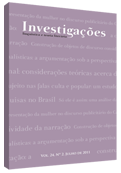Só ele é assim: uma análise da representação da mulher no discurso publicitário do Campari
Abstract
Este artigo se propõe a discutir a representação da mulher, produzida num anúncio publicitário do Campari, através da análise do entrecruzamento de diferentes saberes/sentidos que se inscrevem na Formação Discursiva mercadológica. A fundamentação teórico-metodológica está pautada na teoria da Análise do Discurso francesa sob a abordagem de Michel Pêcheux. Por esse viés teórico, ancoramos e colocamos sob suspeita o(s) sentido(s) que se oferecem como naturais e fixos.References
ALTHUSSER, Louis. 1985. Aparelhos ideológicos do estado. 2 ed. Rio de Janeiro: Graal.
CORACINI, Maria José. 2003. A celebração do outro na constituição da identidade. Revista Organon. 17 (35): 201-220.
COURTINE, Jean-Jacques. 1982. Définition d’orientations theóriques et Constructions de procedures en Analyse du Discours. Philosophiques, V. IX, n. 2.
FOUCAULT, Michel. 2001 (1969). A Arqueologia do saber. 7 ed. Rio de Janeiro: Forense Universitária.
______. 2000 (1979). Microfísica do poder. 15 ed. Rio de Janeiro: Edições Graal.
HALL, Stuart. 2006. A identidade cultural na pós-modernidade. 11 ed. Rio de Janeiro: DP&A.
INDURSKY, Freda. 1998. O sujeito e as feridas narcísicas dos lingüistas. In: Gragoatá, 5: 111-120.
______. 2007. Da interpelação à falha no ritual: a trajetória teórica da noção de formação discursiva. In: Roberto Leiser Baronas (Org.). Análise do discurso: apontamentos para uma história da noção-conceito de formação discursiva. São Carlos: Pedro & João Editores, pp. 75-87.
______. 2008. Unicidade, desdobramento, fragmentação: a trajetória da noção de sujeito em Análise do Discurso. In: Solange Mittmann; Evandra Grigoletto; Ercília Ana Cazarin (Orgs.). Práticas discursivas e identitárias: sujeito e língua. Porto Alegre: Nova Prata, pp. 9-33.
LIPOVETSKY, Gilles. 1989. O império do efêmero: a moda e seu destino nas sociedades modernas. São Paulo: Companhia das Letras.
______. 2000. A terceira mulher: permanência e revolução do feminino. São Paulo: Companhia das Letras.
ORLANDI. Eni P. 1996a. Interpretação: autoria, leitura e efeitos do trabalho simbólico. Petrópolis: Vozes.
______. 1996b. A linguagem e seu funcionamento: as formas do discurso. 4 ed. Campinas: Pontes.
______. 1998. Identidade lingüística escolar. In: Inês Signorini (Org.). Lingua(gem) e identidade: elementos para uma discussão no campo aplicado. Campinas: Mercado de Letras. São Paulo: Fapesp, pp. 203-212.
______. 2001. Análise de discurso: princípios e procedimentos. 3 ed. Campinas: Pontes.
______. (Org.). 2003. A leitura e os leitores. 2 ed. Campinas: Pontes.
PÊCHEUX, Michel; FUCHS, Catherine. 1997 (1975). A propósito da análise automática do discurso: atualizações e perspectivas. In: F. Gadet; T. Hak (Orgs.). Por uma análise automática do discurso: uma introdução à obra de Michel Pêcheux. 3 ed. Campinas: Ed. da Unicamp, pp. 163-252.
PÊCHEUX, Michel. (1969) 1997. Análise automática do discurso (AAD-69). In: F. Gadet; T. Hak (Orgs.). Por uma análise automática do discurso: uma introdução à obra de Michel Pêcheux. 3 ed. Campinas: Ed. da Unicamp, pp. 61-161.
______. (1975) 1995. Semântica e discurso: uma crítica à afirmação do óbvio. 2 ed. Campinas: Ed. da Unicamp.
Revista ELLE. São Paulo: Editora Abril, n. 8, agosto de 2008, p. 79.
Downloads
Published
How to Cite
Issue
Section
License
Copyright (c) 2011 Evandra Grigoletto, Graziela Thais Baggio Pivetta

This work is licensed under a Creative Commons Attribution 4.0 International License.
Authors who publish with Revista Investigações agree to the following terms:
Authors retain copyright and grant the journal right of first publication with the work simultaneously licensed under the Creative Commons Attribution 4.0 International (CC BY 4.0) license that allows others to share the work with an acknowledgement of the work's authorship and initial publication in this journal.
Authors are able to enter into separate, additional contractual arrangements for the non-exclusive distribution of the journal's published version of the work (e.g., post it to an institutional repository or publish it in a book), with an acknowledgement of its initial publication in this journal.
You are free to:
Share — copy and redistribute the material in any medium or format for any purpose, even commercially.
Adapt — remix, transform, and build upon the material for any purpose, even commercially.
The licensor cannot revoke these freedoms as long as you follow the license terms.
Under the following terms:
Attribution — You must give appropriate credit , provide a link to the license, and indicate if changes were made . You may do so in any reasonable manner, but not in any way that suggests the licensor endorses you or your use.
No additional restrictions — You may not apply legal terms or technological measures that legally restrict others from doing anything the license permits.

